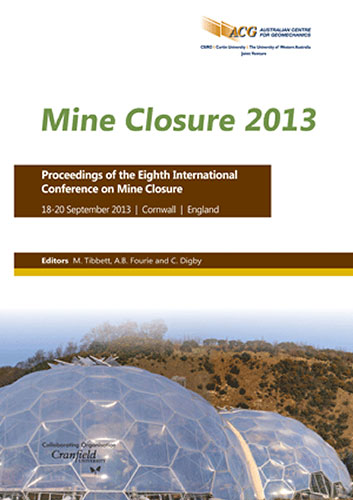The remediation and closure of the former Garryard and Gortmore sites within the historic Silvermines district Ireland

|
Authors: Dey, M; Connelly, R; Czajewski, K; Harding, W; Barnes, A; Bowell, RJ; Cashen, K Paper is not available for download Contact Us |
DOI https://doi.org/10.36487/ACG_rep/1352_26_Dey
Cite As:
Dey, M, Connelly, R, Czajewski, K, Harding, W, Barnes, A, Bowell, RJ & Cashen, K 2013, 'The remediation and closure of the former Garryard and Gortmore sites within the historic Silvermines district Ireland', in M Tibbett, AB Fourie & C Digby (eds), Mine Closure 2013: Proceedings of the Eighth International Seminar on Mine Closure, Australian Centre for Geomechanics, Cornwall, pp. 319-330, https://doi.org/10.36487/ACG_rep/1352_26_Dey
Abstract:
The Silvermines district is located within the county of Tipperary, Ireland. It takes its name from the former extensive mines of lead, zinc, copper, barite and silver that have operated sporadically in the district since 1289, but with more intense operations in the later part of the 19th Century and on into the 20th Century. However, in 1993 all mining operations ceased and the mines were closed. The Department of Communications, Energy and Natural Resources (DCENR) within the Irish government, through their agent North Tipperary County Council (NTCC), have subsequently undertaken rehabilitation of parts of the Silvermines area. Since the closure of the operations a number of studies to assess the risks associated with the sites have been carried out by an interagency group led by the Irish EPA and DCENR, in conjunction with a variety of advisors for specialist input. In 2006 the DCENR obtained funding to commence remediation of the site. After seeking assistance from another consultancy NTCC retained SRK Consulting (UK) Ltd, in partnership with Fehily Timoney and Company, to assist in the final designing of remediation strategies and prioritising of the onsite implementation of the remediation program. The Garryard operation was one of the sites prioritised for remedial works. The Mogul of Ireland mine at Garryard was an underground lead/zinc operation that was active between 1968 and 1982, producing some 9.7 million tonnes of ore grading 2.7% Pb and 7.36% Zn. This ore was stockpiled and processed on surface at a purpose built plant at Garryard and wastes were disposed of both at the Garryard site and then the Gortmore tailings storage facility. When the site was closed there was minimal restoration. However, the presence of sulfide minerals within the wastes has led to the development of acid rock drainage (ARD) that has subsequently released heavy metals in to the aquatic environment. In addition, winds blowing across the tailings facility have resulted in the aerial dispersion of metal enriched dusts. NTCC retained SRK to develop and implement the final strategy to cover the tailings facility at Gortmore to limit both windblown materials and improve water management around the facility, thereby reducing solubilised metal release. The remediation works at Gortmore were completed in 2010. At the Garryard site, SRK proposed a remediation solution for the existing waste within the tailings lagoon that would enable the storage of further problematic mining wastes from the Silvermines area and provided a design for a passive water treatment scheme to minimise the effect of on-going discharges from the site. This paper discusses the engineering issues behind these remediation designs.
References:
Andrew, C.J. (1986) The tectonic-stratigraphic controls to mineralization in the Silvermines area, County Tipperary, Ireland, in Proceedings Geology and Genesis of Mineral Deposits, C.J. Andrew, R.W.A. Crowe, S. Finlay, W.M. Pennell and J.F. Pyne, (eds), 1986, Ireland, Irish Association for Economic Geology, Dublin, pp. 377–418.
Archer, J.B., Sleeman, A.G. and Smith, D.C. (1996) A geological description of Tipperary and adjoining parts of Laois, Kilkenny, Offaly, Clare and Limerick, to accompany the Bedrock Geology 1:100,000 Scale Map Series, Sheet 18, Tipperary, with contributions by K. Claringbold, G. Stanley (Mineral Resources) and G. Wright (Groundwater Resources), Geological Survey of Ireland, 77 p.
Boland, M.B., Clifford, J.A., Meldrum, A.H. and Poustie, A. (1992) Residual base metal and barite mineralization at Silvermines, Co. Tipperary, Ireland, A.A. Bowden, G. Earls, P.G. O’Connor and J.F. Pyne (eds) The Irish Minerals Industry 1980–1990, Irish Association for Economic Geology, Dublin, pp. 247–260.
Golder Associates (2007) Rehabilitation plan for the Gortmore TMF, Silvermines, Co. Tipperary (prepared for North Tipperary County Council).
SRK (2001) Management and rehabilitation of the Silvermines area, Phase II Report: management options, prepared for Department of Marine and Natural Resources.
Stanley, G., Gallagher, V., Ní Mhairtín, F., Brogan, J., Lally, P., Doyle, E. and Farrell, L. (2010) Historic Mine Sites – Inventory and Risk Classification, Vol. 1, Joint study carried out by Environmental Protection Agency and Geological Survey of Ireland.
© Copyright 2025, Australian Centre for Geomechanics (ACG), The University of Western Australia. All rights reserved.
View copyright/legal information
Please direct any queries or error reports to repository-acg@uwa.edu.au
View copyright/legal information
Please direct any queries or error reports to repository-acg@uwa.edu.au